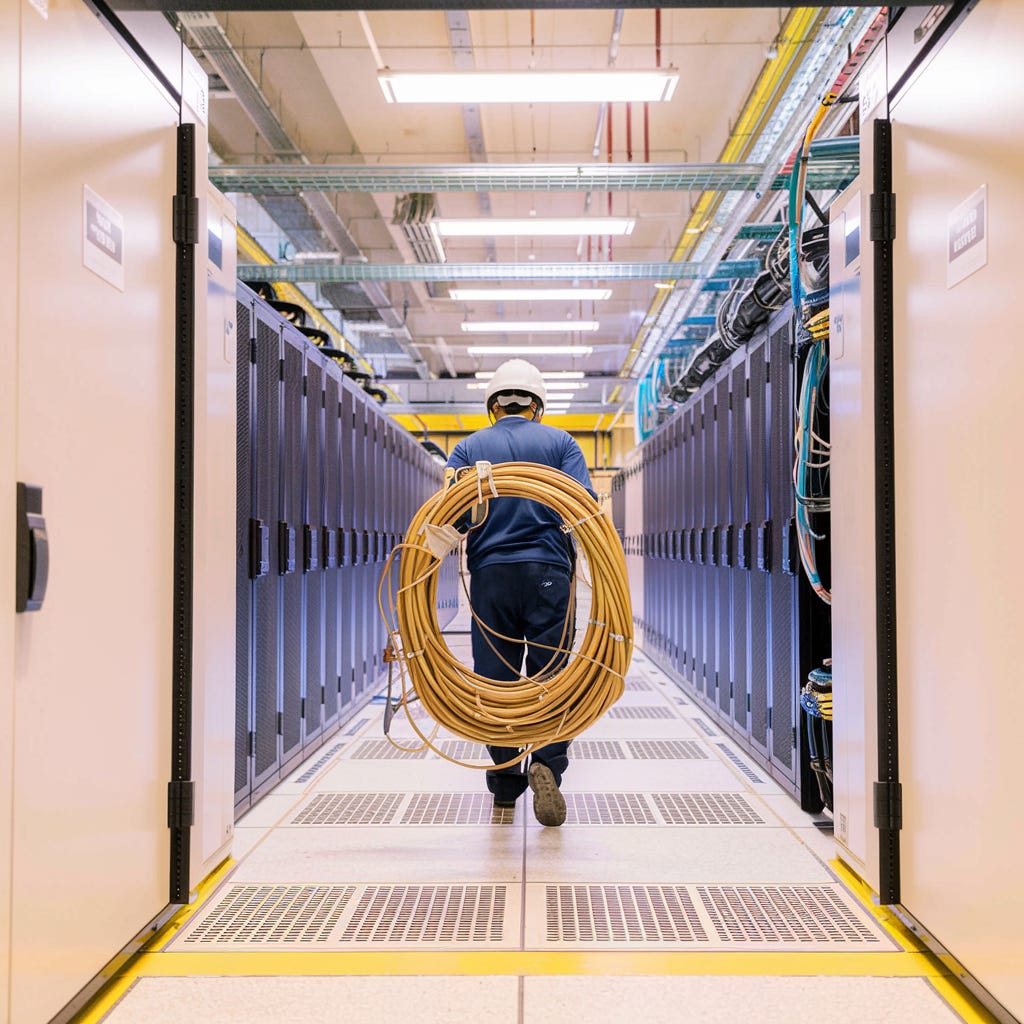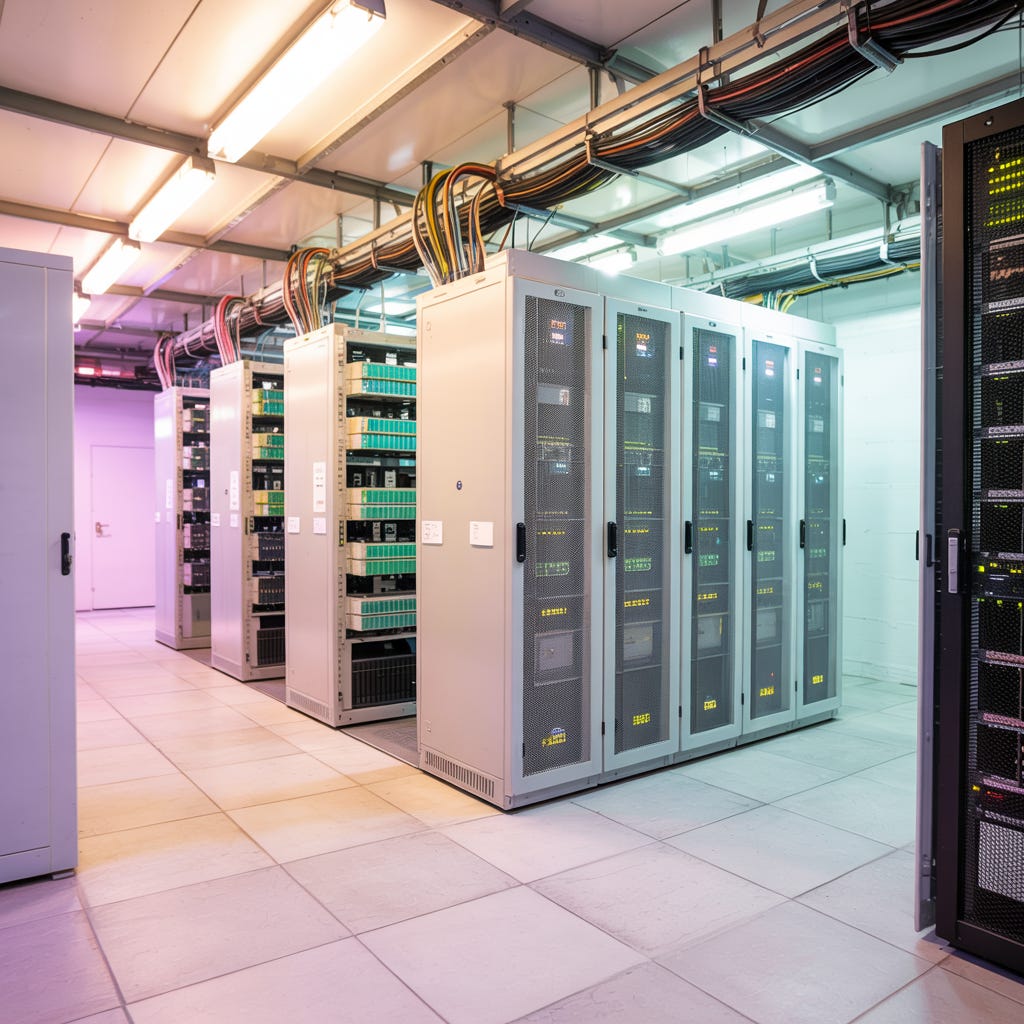How Fiber, Peering, and Cross-Connects Create Moats in Data Centers
Connectivity, not capacity, builds moats. Fiber, peering, and cross-connects decide which data centers compound value and which become stranded warehouses.
Welcome to Global Data Center Hub. Join investors, operators, and innovators reading to stay ahead of the latest trends in the data center sector in developed and emerging markets globally.
This article is the 6th article in the series: From Servers to Sovereign AI: A Free 18-Lesson Guide to Mastering the Data Center Industry
From the outside, a data center seems like a fortress of concrete and steel. Step inside, and you’ll find thousands of servers, miles of cabling, and enough power equipment to rival a small utility.
But none of it matters without connectivity.
Power keeps machines alive. Cooling ensures they don’t overheat. Yet the network is what allows data to flow in and out. It’s the nervous system of the digital economy—the piece that turns a warehouse of machines into a living node on the global internet.
Without fiber, cross-connects, and peering, a data center is just an island. With them, it becomes the gravitational hub of an ecosystem.
Fiber: The Arteries of Value
At first glance, fiber is simply strands of glass. But where those strands go, and how they’re engineered, determines whether a facility is resilient or fragile.
A single path to the outside world is a liability. One backhoe, one splice cut, and an entire campus can go dark. That’s why serious operators design multiple, geographically diverse routes into long-haul backbones, central offices, and subsea landing stations. The smartest secure indefeasible rights of use on dark fiber, locking in control for decades and aligning those rights with tenant lease terms.
For investors, the fiber map isn’t a side document it’s a covenant. It reveals whether resilience is engineered into the asset or left to chance.
Meet-Me Rooms: The Marketplaces Inside the Walls
The beating heart of interconnection isn’t out in the street; it’s inside the facility. The meet-me room is where carriers, clouds, and enterprises plug into one another.
Every additional participant multiplies the value of the whole. A new carrier doesn’t just connect to the operator—it opens dozens of potential private connections to everyone else in the building. This compounding effect explains why carrier hotels like 60 Hudson in New York or Equinix SG1 in Singapore command extraordinary premiums. They aren’t the newest buildings or the largest by power, but their dense ecosystems make them irreplaceable.
The meet-me room is where an ordinary colocation site becomes an economic hub.
Cross-Connects: The Cables That Behave Like Annuities
Cross-connects look mundane. They’re just short cables linking one tenant to another or to a cloud service. But on the income statement, they’re gold.
The economics are simple but powerful: a small installation fee plus recurring monthly charges, with minimal operating cost. Once a tenant establishes multiple cross-connects, moving workloads elsewhere becomes prohibitively expensive. Every new connection compounds stickiness, raises switching costs, and increases the predictability of revenue.
That’s why investors often study cross-connect velocity—how many new links are added per tenant per quarter—as a leading indicator of margin expansion and renewal probability.
Internet Exchanges: The Invisible Gravity
If fiber is the arteries and meet-me rooms are the marketplaces, internet exchanges are the gravitational pull.
By allowing networks to peer directly, IXPs cut transit costs, reduce latency, and improve reliability. Their presence can tilt the economics of entire metros. Frankfurt’s DE-CIX, Amsterdam’s AMS-IX, and Equinix’s Ashburn exchange illustrate the dynamic: dense peering attracts networks, SaaS providers, and hyperscalers, which in turn attract investors.
Facilities tied into strong exchanges don’t just rent space. They become the meeting points of the digital economy.
Why Connectivity Dictates Capital Flows
Look at where institutional capital continues to concentrate: Ashburn, Amsterdam, Singapore. The common thread isn’t just megawatts or land—it’s connectivity. These hubs sit at the intersection of subsea cables, dense carrier hotels, and powerful internet exchanges.
That’s why capital keeps chasing the same few buildings, and why power-rich but fiber-poor sites often underperform. A facility can lease its first phase, but without network gravity, churn rises and valuation multiples sag.
Connectivity explains why carrier hotels with modest capacity command higher multiples than newer, larger shells. It explains why subsea-adjacent markets like Marseille or Mombasa suddenly become magnets for investment once landing stations go live.
Real-World Dynamics
Operators at the cutting edge are already reshaping their businesses around connectivity. CoreWeave has built specialized interconnects designed for AI inference clusters where microseconds matter. Meta has quietly become one of the largest private fiber owners in the world, controlling latency end to end. Edge operators prioritize proximity to population centers, often valuing low-latency routes more than raw power density.
Each of these strategies underscores the same truth: network isn’t plumbing. It’s positioning.
Final Takeaway
Fiber, meet-me rooms, cross-connects, and internet exchanges are not technical trivia. They are the hidden levers that determine whether a facility becomes a commodity or a compounding asset.
Here’s the asymmetry: megawatts are visible to everyone, but connectivity is often misunderstood or underappreciated. The investors who can evaluate it rigorously—reading fiber maps like balance sheets, treating cross-connect velocity like a financial KPI, and pricing internet exchange gravity into their models—gain an advantage the broader market overlooks.
In other words, connectivity is the place where diligence effort is low, but payoff is high. That’s the edge.
So I’ll leave you with this: if you could only double one resource in your next build—generator capacity or fiber routes—which would you choose, and why?




Such a great breakdown on data centers. Interesting to see how this progresses.
Good piece. Mostly correct. The most correct part was that the majority of people do not know, or properly understand what neutral interconnection infrastructure is. It is its own business model.
Meet Me Rooms are NOT data centers.
IX’s and IXP’s are not the same. IX is an ethernet switch, IXP is the room, or building the IX is in. These terms have been conflated and therefore debated, but if they were the same thing why would we need both terms?
The “Meet Me Street” is a real thing. Neutral splice cases are a real thing. So, not everything happens in the building. Look at Towardex in Boston.
Not all cross connects are billed on a monthly recurring basis. Many MMR operators offer $0MRC CC’s.
MRC cross connect fees are actively being AVOIDED by carriers and Hypers. Look at Lumen’s new offering specifically to bypass Equinix…
"What we're offering is a direct connection where those cross-connect fees are no longer needed. And that's disruptive, obviously, to the data center companies."
- Kate Johnson CEO Lumen
Network latency (RTD) and GPU cluster latency (InfiniBand) are not the same.
The definition of words and terms matter. Ask any lawyer.